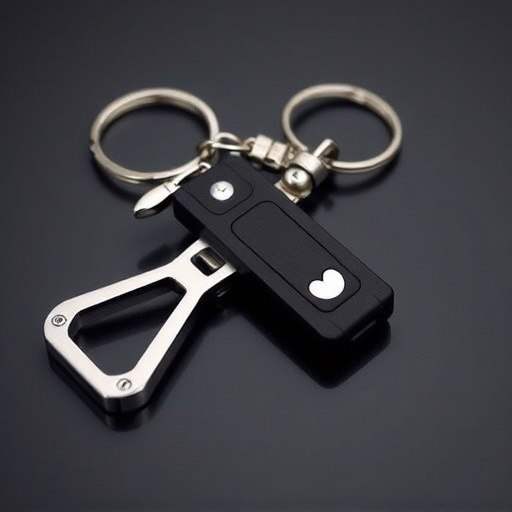Designing an effective keychain self-defense tool requires understanding key pressure targets on the body, focusing on vulnerable areas like hands and arms. Ergonomic design ensures comfort for precise control during emergencies. Choosing durable materials like stainless steel or aluminum alloys is crucial for reliability and effectiveness. Balancing metal hardness and workability ensures optimal performance. Ergonomics cater to various hand sizes, minimizing pressure points for user comfort in stressful situations. Incorporating specific pressure point techniques allows temporary disability of attackers, providing escape chances without causing permanent harm. Regular practice ensures smooth execution under stress.
“Elevate your personal safety with an innovative approach: metal defense keychain grip design. In today’s world, self-defense is a crucial consideration, and a well-crafted keychain can be a powerful tool. This article explores the art of designing keychains as pressure targets, guiding you through essential aspects such as choosing the right metal, achieving ergonomic comfort, and incorporating effective pressure points. Discover tips to create a secure grip that empowers you to stay prepared and confident.”
- Understanding Keychain Self-Defense Pressure Targets
- Choosing the Right Metal for Your Grip Design
- Ergonomics and Comfort: Creating a Secure Grip
- Incorporating Pressure Points and Techniques
Understanding Keychain Self-Defense Pressure Targets
When considering a keychain self-defense grip design, understanding the concept of keychain self-defense pressure targets is paramount. These targets focus on vulnerable areas of the body that can be effectively pressured or manipulated to incapacitate an assailant. The hands and arms are particularly sensitive zones due to their rich nerve endings and vital functions in balance and movement. A well-designed keychain should leverage these points, aiming to apply pressure that disrupts fine motor skills, prevents effective striking, or even induces temporary numbness or pain.
Designers must also consider the ergonomic fit of the keychain within the user’s hand. Comfortable gripping ensures precise control during an emergency situation. The surface texture and overall shape should facilitate a secure, instinctive grasp, enabling swift deployment and accurate target pressure. By integrating these principles, a metal defense keychain can transition from everyday accessory to potent self-defense tool in moments of need.
Choosing the Right Metal for Your Grip Design
When designing a keychain self-defense pressure target, selecting the suitable metal is a critical step. The right metal can enhance grip comfort and durability, making it ideal for everyday carry and potential defense scenarios. Look for metals like stainless steel or aluminum alloys, known for their strength-to-weight ratio and corrosion resistance. These materials offer excellent craftsmanship opportunities, allowing for precise design elements that improve both functionality and aesthetic appeal.
Consider the balance between metal hardness and workability. Harder metals like carbon steel can provide a sharper edge but may be more challenging to shape. Softer metals, such as certain grades of aluminum, are easier to cut and form but might not hold up to frequent use or intense pressure as effectively. Balancing these factors ensures your keychain grip design delivers both performance and reliability when it matters most.
Ergonomics and Comfort: Creating a Secure Grip
Ergonomics plays a vital role in designing a keychain self-defense tool that’s both effective and comfortable to use. The grip should be designed to fit naturally within the hand, ensuring a secure and stable hold. Consider the shape and size of various hands to create a universal yet personalized grip. A well-designed keychain grip should minimize pressure points, especially when targeting delicate areas like pressure points or nerve endings. This comfort is crucial for users to maintain control during stressful situations.
Focusing on ergonomics also allows for the integration of multiple defense mechanisms into one compact tool. By optimizing the grip, you can enhance the precision and force behind each strike, making it easier to defend oneself effectively. Whether as a self-defense pressure target or a last resort tool, a keychain designed with comfort in mind offers peace of mind and ensures users can react swiftly and accurately when needed.
Incorporating Pressure Points and Techniques
Incorporating pressure points into your keychain self-defense strategy is a game-changer. By understanding and utilizing specific pressure targets on the body, you can disable an attacker effectively even with a small defense keychain. Keychain self-defense pressure techniques focus on vulnerable areas like the eyes, throat, groin, and knees, which, when targeted precisely, can render an opponent incapacitated.
These techniques are designed to be quick, precise, and efficient. Practice targeting these pressure points regularly to ensure you can execute them smoothly under stress. Remember, the goal is not to cause permanent harm but to temporarily disable your assailant, giving you the chance to escape.
When designing a metal defense keychain grip, it’s crucial to balance functionality, comfort, and materials. By understanding the effectiveness of keychain self-defense pressure targets and incorporating ergonomic design principles, you can create a secure and reliable tool. Choose durable metals, optimize grip points for comfortable use, and practice associated techniques to ensure your keychain serves as an effective personal defense mechanism in unexpected situations.
